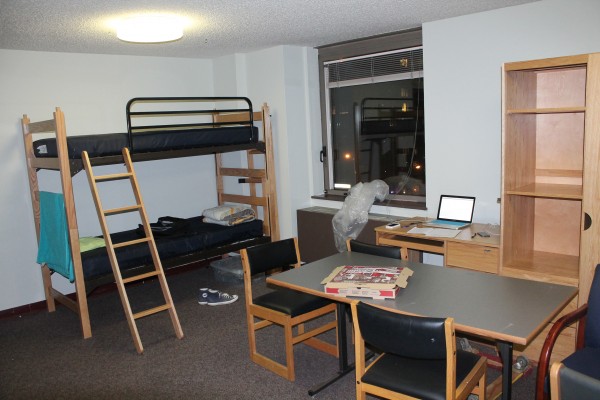Bed Bugs Confirmed in Two Apartments At McMahon Hall
March 13, 2014

Two apartments in McMahon Hall at Fordham College at Lincoln Center (FCLC) have been treated for bed bugs, Dean of Students Keith Eldredge confirmed on Tuesday, March 11.
It is the University’s policy to not inform all residents of McMahon when cases of bed bugs have been confirmed. “There is really not something different that folks need to do with the bed bugs so I think that’s probably why we haven’t done a big alert,” Eldredge said.
“We’ll treat that room aggressively, we’ll put monitors in surrounding areas, just in case, and there is not a process right now where we would notify the whole building,” Eldredge said.
Precautions to prevent the sprinkler system from being discharged have been put in place while thermal treatment is being conducted, according to Eldredge.
The flooding in McMahon Hall that occurred Sunday, Feb. 9 was a result of the sprinkler system that was discharged by the thermal treatment occurring on the 9th floor. “We’ve had—I don’t have an exact number—numerous thermal treatments for bed bugs over the years,” Eldredge said. “There was a mistake with the way they covered a sprinkler head and something got knocked loose or wasn’t attached, so that resulted in the sprinkler being activated.”
Apartments affected by the sprinkler discharge incident included 9M, 9L, 9A, 8M, 7M, 4M and 3M, according to an email from the Office of Residential Life to students who had to be relocated to the Hudson Hotel from Thursday, Feb. 20 to Monday, Feb. 24.
According to Eldredge, standard procedure when the University receives reports from students about possible bed bugs is to have an exterminator examine the apartment to confirm the existence of bed bugs before a treatment can be administered.
“So we will respond to all of them and put down the traps, bring in the dog, do different things to try to assess because we can’t really do a full treatment unless we have confirmation,” Eldredge said. Students are sent to the Health Center or their own physician if they report bites.
“We probably get a report a week that someone suspects bed bugs and almost all of the time it is some other kind of bug bite, it’s a reaction to a laundry detergent switch or an allergic reaction to something people ate, or something else,” Eldredge said. “[Doctors] can look and say something, ‘That’s a bug bite,’ versus some other kind of medical reaction, an allergic reaction or a rash. But they can’t say that that is a bug bite.”
Jeff Zhang, FCLC ’17 and a student in apartment 4H of McMahon Hall, said that at around 10:00 p.m. on Sunday, March 9 one of his roommates found a bed bug in his room. A member of ResLife stopped by the apartment the following morning.
“He found one and he killed it and we looked for more,” Andrew Lanser, FCLC ’17 and a 4H resident, said. A dog was brought by the apartment around 4:30 p.m. on Monday, March 10 to detect the presence of bed bugs, according to Sam Denholtz, FCLC ’17 and 4H resident. After confirming the presence of bed bugs in their apartment, the members of 4H were then moved to 4A, the vacant apartment reserved for faculty-in-residence, at around 6:00 p.m.
The living room in the vacant apartment was converted into a bedroom to properly accommodate all of the students relocated from the apartment with the bed bug incident. The members of the apartment were instructed to do laundry, bring clean clothes and only take the essentials and that their stay in 4A would last about two or three days. In total, seven people were moved from 4H to 4A.
Though bed bugs are known for travelling between apartments in New York, this is not the case in McMahon Hall due to its construction, Eldredge said. “It is a different style of architecture, with the cement slabs that are used for the floors and the types of cinder block walls in a lot of the areas that makes it much, much more difficult for the bugs to travel then it would in different types of facilities.
“We have had situations where somebody gets bed bugs in an apartment, and we find it in another apartment. It’s because these people are friends and are going back and forth with each other sometimes,” Eldredge said.
According to the Center for Disease Control and Prevention (CDC), bed bugs “are small, flat, parasitic insects that feed solely on the blood of people and animals while they sleep.
Bed bugs are reddish-brown in color, wingless, range from 1mm to 7mm (roughly the size of Lincoln’s head on a penny), and can live several months without a blood meal.”
Bed bugs are able to travel over 100 feet in a night, “but tend to live within 8 feet of where people sleep.” Bed bugs are not commonly known to spread disease.
According to the CDC, the tell-tale signs of a bed bug infestation is bite marks on the face, neck, arms, hands or other body parts, contracted while sleeping. “These bite marks may take as long as 14 days to develop in some people so it is important to look for other clues when determining if bed bugs have infested an area. These signs include: the bed bugs’ exoskeletons after molting; bed bugs in the fold of mattresses and sheets; rusty–colored blood spots due to their blood-filled fecal material that they excrete on the mattress or nearby furniture; and a sweet musty odor.”
Additional reporting by Ian McKenna.











